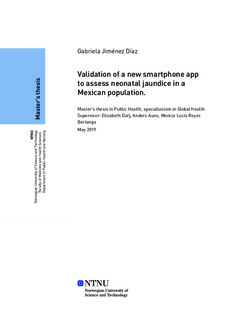| dc.description.abstract | Background: Neonatal jaundice is a common and temporary finding in newborns but severe cases can progress to bilirubin encephalopathy and kernicterus which may have serious or fatal consequences. Early detection can be accurately done through a total serum bilirubin measurement with a blood test or a transcutaneous bilirubinometer, which are not available in most health centres because their high cost. Neonatal jaundice related mortality is still high in the poorest regions of the world and is frequently associated with the delay in the diagnosis of hyperbilirubinemia. Therefore, there is a need to a reliable, accurate and affordable method to timely detect high risk newborns. Several mHealth technologies have been developed to address this need, using smartphones and apps that can be used as point-of-care diagnostic devices. A new smartphone app to detect neonatal jaundice has been developed at Norwegian University of Science and Technology which has already been tested in a Caucasian population with good results. The present study aims to test its performance and accuracy in newborns with different skin colour, since melanin can potentially influence the results.
Design and methods: A descriptive cross-sectional study was carried out at Hospital Materno- Infantil de Irapuato in Mexico during July and August 2018. Using a calibration card placed on the chest, images of healthy newborns with and without jaundice were obtained using a smartphone camera within 60 minutes of a blood test to measure total serum bilirubin was done. Image analysis was done with the algorithm developed at Norwegian University of Science and Technology. Date and time of birth, birthweight and gestational age were obtained from medical records. Kramer scale of the newborns and Fitzpatrick scale of parents were determined. Correlation between TSB levels and estimated levels of bilirubin obtained with the app and Kramer scale were calculated. The app and Kramer scale sensitivity, specificity and predictive values for screening jaundice were also calculated.
Results: The correlation between TSB levels and the app estimated levels was 0.87 and between TSB and Kramer scale 0.80. For TSB cut off value of 255 mol/l and app value of 186 and 200 mol/l, sensitivity was 100% and 90% and specificity 79.5% and 80.1% respectively. Kramer scale sensitivity to detect jaundice was 72% with 87% specificity.
Conclusion: The new smartphone app provided accurate estimates of TSB levels in a Mexican population of newborns. It can have a role as an affordable, available and accurate supporting diagnosis tool to screen NNJ and closely follow-up newborns with risk to develop dangerous levels of bilirubin in different health care settings. | |
